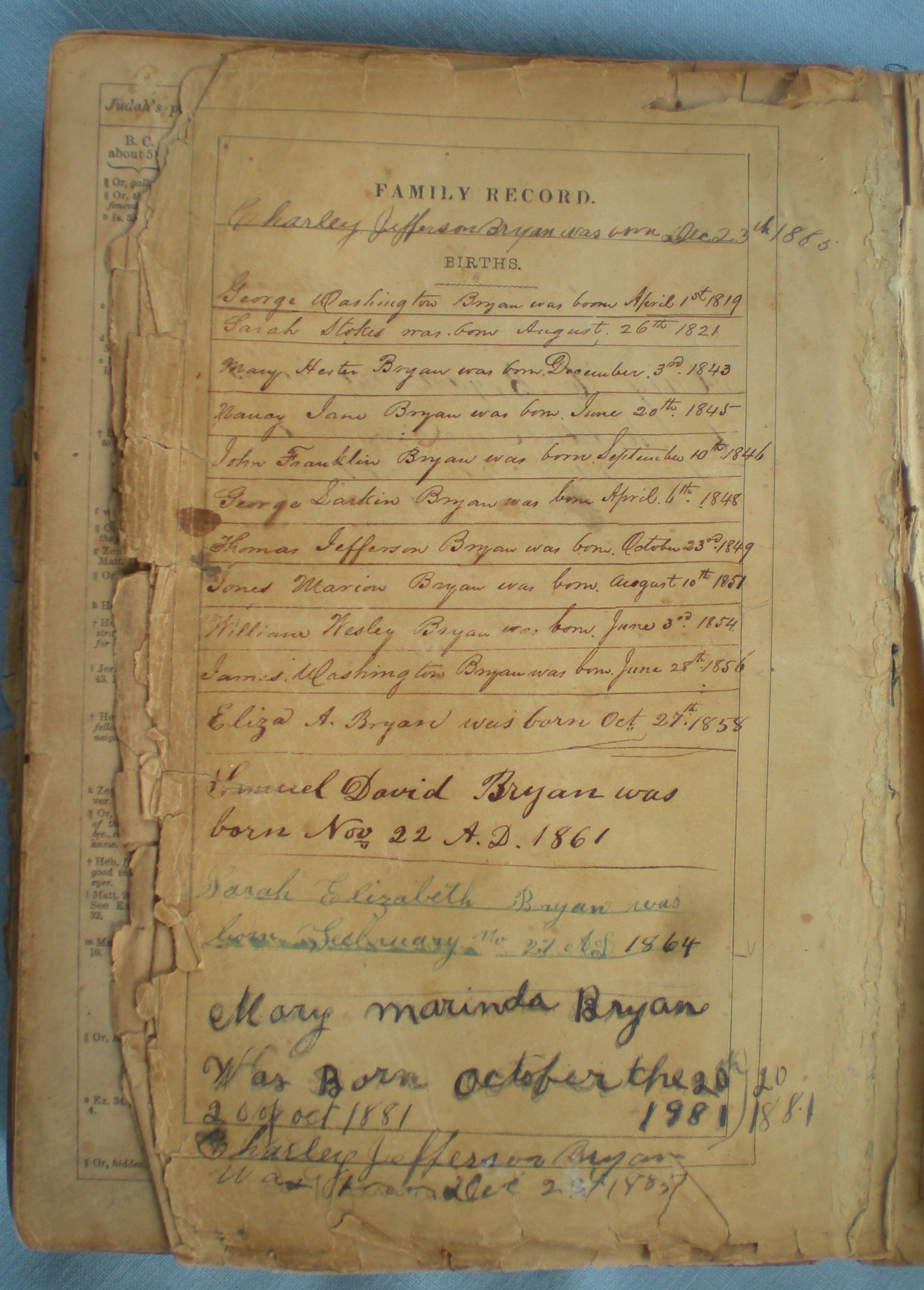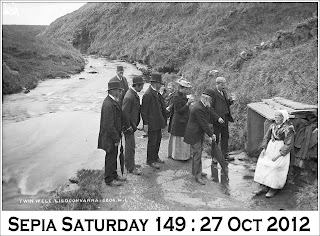Related Posts:
Treasure Chest Thursday – Bryan Family Bible
Bryan Family Bible – The Best Laid Plans
Bryan Family Bible – To Honor a Life
I started going in one direction with this post but turned onto a different path. If you have been following along, I am sure it has become clear to you that I have no plan. I’m just sitting with this Bible my ancestors once held in their hands and looking at the remnants left behind. Ink. Handwriting. Dates. Lives. Loves. Losses. Smudges. Watermarks. Wondering what I can squeeze out of these old pages in a Bible…
This time around I’ve been trying to discover/prove who wrote the earliest entries in the Bible. I think it was George Washington Bryan. I’ll tell you why and try to see if I can pick up on any clues to the other writers while I’m at it. I hope you’ll offer your opinions too!
A short recap:
George Washington Bryan and Sarah Stokes (entries 2 and 3) on the Births page below were the head of the family to whom this Bible belonged. Their births are recorded and the births of their 11 children follow beginning with Mary Hester in 1843 and ending with Sarah Elizabeth in 1864.
In a previous post, I took a look at a portion of this page – which is the second Births page – and made the case that, disregarding the entry at the top of the page, the birth entries beginning with George Washington Bryan and ending with Eliza Ann Bryan were written at the same time – following the death of Eliza Ann, a baby who did not survive the day of her birth. And that the first Marriage entry and the first two death entries were also written by the same person at the same time. Now I want to see if I can make a case that the writer was George Washington Bryan.
I found a transcribed letter written by George Washington Bryan on the internet some years ago, but there was not a scan of the actual letter. It would have been written within a few years of the entries on this Births page and would have helped to confirm whether or not this handwriting belongs to George. I surely would like to see a scan of that letter!
Here is what I do have to draw from:
* This Bible belonged to the family of George Washington Bryan and Sarah Bryan nee Stokes. There is no information in the Bible about anyone born before these two individuals and all of the information pertains to them, their children, and their grandchildren. Seems logical that the first writer in the Bible was either George or Sarah.
* When the first marriage entry was recorded – the marriage of George and Sarah – the writer unconsciously wrote baby Eliza’s name instead of Sarah’s. It makes sense to me that George, in this time of grief, made this mistake. If the baby’s mother, Sarah, had written the entries, it seems less likely to me that she would have made a mistake with her own name.
* I have not researched the tradition at the time, but I would guess that the “head” or husband of the family often assumed the task of recording the family history in family Bibles. Please correct me here if I am wrong.
* George and Sarah migrated from Kentucky to Missouri in 1854 and left most of their family behind except the John Wesley Bryan family who migrated with them. John was George’s brother and John’s wife, Nancy, was Sarah’s sister. Sarah’s and Nancy’s parents had also made the journey but did not stay in Missouri. It is unclear if they were present in 1858. The John Wesley Bryan family may have been with George and Sarah – assisting with the birth and/or present with the family for the burial. Could one of them have taken on the task of recording the first entries in the Bible when baby Eliza died? I suppose so. But it seems unlikely.
* The handwriting is neat and well practiced, leading to the assumption that the writer had some years of schooling. In an unpublished genealogy written by Edna Ruth Starling in 1958, “Roses in December”, she wrote this about George: “George Washington Bryan was teaching school in Todd County, Kentucky. He and his brother, John Wesley Bryan, had married sisters and their two families were very close. In the spring of 1859, they hitched their oxen to a couple of prairie schooners and joined a wagon train. Some of the Keeling family came along.” (Other evidence suggests that the move west was actually in 1854, not 1859.)
I have never seen any other documentation that George was a school teacher. If Edna Starling’s story is correct, neat and legible handwriting would likely have been part of George’s skill set as a teacher. Census records for 1850 and 1860 show George’s occupation as “farmer”.
* What about Sarah? Could she have written these early entries? I don’t know much about Sarah’s early life – whether or not she attended school, for example. In addition to my previously stated reasons for discounting her is the simple fact that she had just delivered a baby that did not survive the pregnancy/delivery or was unable to survive after birth. She was likely in a time of physical recovery as well as grief.
* The oldest child in the family, Mary Hester, was 14 at the time of Eliza’s birth and death. It is possible that she could have recorded these entries, but doubtful. The handwriting seems too mature and the organization of the entries and layout are so well executed.
* The most compelling reason to think that George Washington Bryan was the one with the lovely penmanship is that he died in January of 1864, so any entries made by George would have ended before 1864. In my opinion, there are no entries after 1861 that match these early entries.
Here are writing samples for comparison:

The entry for Samuel David Bryan looks like it could have been written by the same person as the entries above it even though it is larger and not as constrained as the earlier writing. Samuel’s birth was a happy event, unlike the birth and death of Eliza, so I think this could account for the difference.
The birth of Sarah Elizabeth Bryan, in the blue ink, is similar in style to the earlier entries, but the slant and proportion is different. I don’t think it is a match.
The rest of the handwriting on this page has nothing in common with the earlier writing.

Looking at other pages of the Bible, only the first two entries on both the Deaths page and the Marriages page below appear to match the early writing on the births page. The marriage of Mary Hester (page on right) looks like a match to me – although much larger than the early entries. Again, I attribute this to the difference in emotion.
 The two “happy event and larger” handwriting samples record events in 1861. Even if they are not written by the earlier writer, they do not eliminate the possibility that the first writer was George.
The two “happy event and larger” handwriting samples record events in 1861. Even if they are not written by the earlier writer, they do not eliminate the possibility that the first writer was George.
I could be completely wrong, but I think George wrote everything up to and including those dated 1861.
So what do you think? Can I add this to my collection of ancestor signatures?
 With the caveat, of course, that it is just my opinion.
With the caveat, of course, that it is just my opinion.




